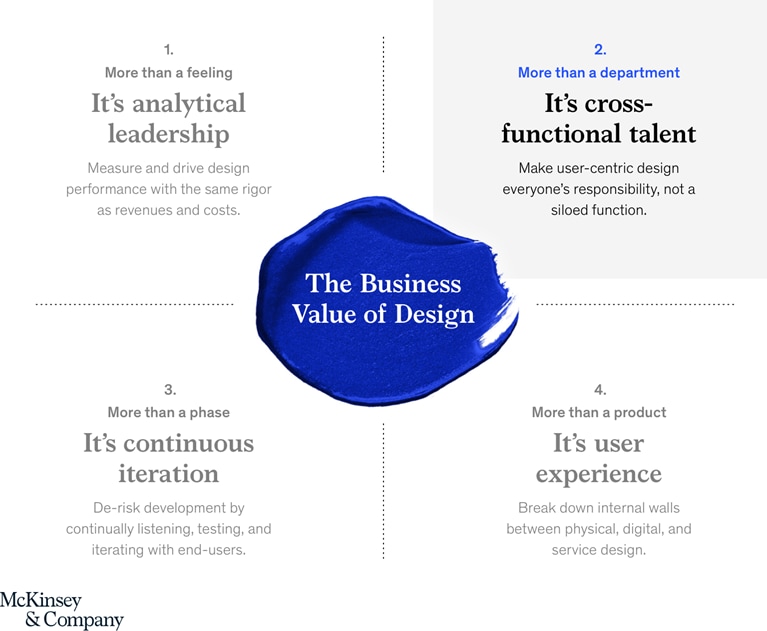In a world full of disruption, approaches that have been the bedrock of strategies no longer provide complete answers. Historical data and inside-out analysis can’t be extrapolated with the same certainty. And entire industries have been reshaped so dramatically that the competitive landscape remains frustratingly fluid, raising a question: to stay relevant, where should companies focus?
To solve these new challenges, companies need new approaches to strategy. Design—and design thinking—is uniquely suited to complement traditional strategy, filling in factual gaps with a user-centric perspective that can help organizations rebound from downturns and improve performance over the long term. Our research has shown that companies that bring design thinking and design leaders into strategic planning generate significantly higher returns for shareholders while enabling their organizations to proceed with greater confidence in the face of shifting landscapes.
Why design?
Since the publication of our 2018 findings on the business value of design, executives have become better acquainted with what design is and how it can generate value across four main areas:

As designers, we can create additional impact in these four areas in two distinct ways:
Human-centric insights jump-start growth
Designers innately put the human experience at the center of problem solving, and the pandemic was just the latest chapter in the rising influence of the consumer. Companies that focused on customer insights during past crises proved more resilient and changed the angle of their growth trajectory in the ensuing years. For example, during the Great Recession of 2008–09, customer-centric companies outperformed their peers by 10 percent. They also experienced a quicker recovery: just three years on, that performance advantage had grown to 30 percent, fueled in part by their skill in using customer insights to spur growth. Ensuring that a company focuses its hard-fought investment capital on what its customers need makes logical sense on top of delivering better economic outcomes.
Catalyst for innovation
Companies seeking to grow beyond their core often innovate by creating new products and services or expanding into new geographies. When going to market in a new space, executives can’t rely only on past performance or data; in many cases, they don’t have any. In such instances, design-thinking methods can help derisk that investment by bringing together leading (versus lagging) customer insights and applying perspectives from other industries or geographies to build more confidence that a new direction is sound. By aspiring to understand what customers want and need and by looking at how players both within and outside of their industry are influencing those needs, companies can explore multiple scenarios and use a qualitative and quantitative fact base to hone their strategy.
Redesigning the design department
Our latest report, Redesigning the design department, highlights several steps companies can take to unlock the full potential of design in their organizations.
Design the strategy
Too often, designers are tasked with simply executing strategy rather than contributing to it. However, by embedding design into strategic planning and development, companies can become far more effective at properly defining and framing a business problem. That sets the stage for creating more innovative solutions, as well as for reducing missteps.
Design the business
Designers can not only have a massive impact on the quality of a product but also can improve how the organization functions. Design can help to reimagine processes and spur collaborative, symbiotic problem solving. For example, we are seeing an increased focus on defining the future of work, whether in a physical environment, hybrid work policies, or other areas. Designers and design-thinking methods can help proactively shape the company’s approach by surfacing the employee view and a forward-looking “art of the possible” approach. These lenses can help a company define better solutions for its employees (and, ultimately, benefit from their better performance) and potentially attract talent from competitors that are not examining the new needs and demands of employees.
Design cross-functional teams
Many companies have centralized their design function in the hope that this critical mass will lead to better outcomes and happier talent. When we summarized our latest findings by stating that design needs to move “from the ivory tower to the town square,” we meant integrating design into other cross-functional teams to solve problems together. When organizations do that, it ensures that multiple perspectives are applied to problems, and it minimizes the “not invented here” siloed thinking that can inhibit organizations.
Maximizing the impact of design
Moving forward, almost every leader will need to combine elements of traditional strategy and design thinking to excel and innovate in an evolving, uncertain environment. Design and nondesign leaders need to bridge their own skills with the needs and vocabulary of their peers. Designers specifically will need to know the levers that drive execution, reduce costs, and scale and optimize the business as much as they know how to hone their craft and deliver successful products, services, and experiences.
Opportunities and possibilities for innovation will be plentiful when organizations fuse design and its problem-solving methodology into all areas. The best outcomes will be elevated structures and strategy, boosting the odds for success. And by focusing on the needs of the customers and their employees, companies can build loyalty and outcomes that are at a premium in both good and uncertain times.
****
Successful transformations and innovations include design and design thinking from the outset to help inform the process, create high-performing teams, and bridge any gaps between customer or employee behavior and the ultimate goals of a company. Breaking design out of a siloed department by moving designers into cross-functional teams is one step CEOs and chief design officers can implement to jump-start growth in key areas of their business.
Get the latest insights on the business value of design from our more recent report: Redesigning the design department.
